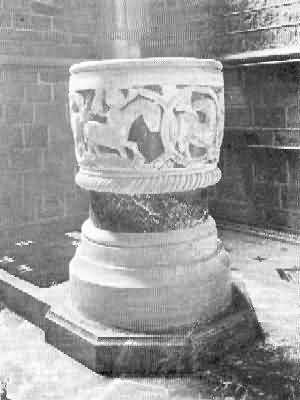
«SOME OLD DEVON CHURCHES» BY JOHN STABB; 217-228
St. Mary Church [217]; Stockleigh English [218]; Stockleigh Pomeroy [219]; Stoke Canon [220]; Stoke Fleming [221]; Stoke Gabriel [222]; Stoke-in-Teignhead [223]; Stokenham [224]; Sutcombe [225]; Swymbridge [226]; Talaton [227]; Tawstock [228].
ST. MARY CHURCH. St. Mary. This parish church is said to have been the earliest in Devon. In Domesday Book [1086] it is called «Saint Marie Churche». The present fabric was rebuilt in 1861 and consists of chancel, nave, north and south aisles, south porch, and west tower containing eight bells, cast and hung in 1880. The tower was restored in 1873 at a cost of £3,500 in memory of Bishop Phillpotts [1778-1869], of Exeter, who is buried in the churchyard.
The great object of interest in this church is the old font [plates 217a, 217b, 217c, and 217d]. There is a rather remarkable history attached to it. Before 1824 the lower part was uppermost and the upper part was buried in the floor. In 1824 the floor was repaired when the carving was discovered on the lower portion; on examination this proved to be the original font and it was then placed in its original position. The bowl is ornamented with a rim about twelve inches in depth, consisting of seven rings intersecting each other and decorated with beads or studs; within these rings are carved figures of very rude workmanship.
In Dr. Oliver's Ecclesiastical Antiquities, Vol. 1, p. 184, the following list is given:—
"1st. A bird (probably a dove) with a bunch of grapes or olives in its beak.
2nd. A boar baited by a dog.
3rd. A man with a bugle in his right hand, and a dog by his right side, his left hand holding a spear.
4th. A man falling head over heads, nearly doubled, with a sword in his hand, Qy. if Goliath?
5th. A figure in a chair, playing on a harp, Qy. if David?
6th. A man on horseback, blowing a bugle, which he holds in his left hand, with a sword in his right.
7th. A Salamander, emblematic of fire, with the head of regardant."
I have given the list of carvings with Dr. Oliver's ideas as to the meanings, but I think he is incorrect in his conclusions. Of course, when dealing with symbolism in art it is possible to start with a preconceived idea, and to make everything work in with that idea. Necessarily where there are no documents in existence describing what the carvers of the font intended to represent, imagination must come largely into play in deciphering the carvings.
There have been at least three papers published on this font: those by Miss Minna Gray, Miss Kate M. Clarke, and Miss Mary Salter. To take the last first, Miss Salter placed the date of the font long before Saxon times, in fact she does not think it was originally used as a font but as a divining well. The following account of its origin is from her point of view:— "The church of the parish of St. Mary Church is the fourth which has been built on the same site; a Phœnician temple probably once occupied the same spot, as I found the font to have been an ancient divining well, containing a valuable record of the religious and physical history of the Phœnicians and Cimmerians. The seven-ringed carving has been inscribed at various times with Phœnician or Archaic Hebrew characters, Greek and Egyptian letters and hieroglyphs; lastly, it was whitewashed, and that part of Domesday Book which relates to the neighbourhood painted in a darker tone on it. This has nearly all disappeared under the vigorous cleaning to which the font has been subjected. The character inscribed on it form a valuable link between the north western and south eastern alphabets. The original font was funnel shaped; it has been turned upside down and the carving buried to preserve it from the Puritans, and an octagonal top placed on the upturned bottom."
Miss Minna Gray, in her paper read before the Exeter Diocesan Archæological and Architectural Society, in 1905, divides the carvings into three pairs and a single panel. The first two, the boar baited by a dog, and the man with a bugle, she thinks represents a hunt; the hunter a priest, for he is arrayed in a chasuble, and the quarry the unclean swine, symbolical of demonical possession; or, in other words, these panels are symbolical of the casting of the Devil and all his works.
The next two panels, the dancing girl* and the harper, Miss Gray thinks are fitting types of the pomps and vanities of the world renounced in baptism. (* Dr. Oliver is clearly wrong in describing this figure as a man; the accordion-pleated skirt can be plainly seen on the panel here, which is almost identical with the carving on the font at South Milton.)
The third pair of panels represent another hunting scene, a mounted hunter pursuing a beast of undefined species. This Miss Gray thinks represent the evil one pursuing souls.
In E. P. Evans' Animal Symbolism in Ecclesiastical Architecture is an illustration of a scene very similar in which the animal is called a beaver; after a description of the engraving follows this passage, "But though, O man, separate from thyself the works of the flesh . . . . and throw them to the devil who hunteth after thy soul, saying 'I will pursue my enemies and overtake them.' Then canst thou exclaim with the Psalmist, 'our soul is escaped as a bird out of the snare of the fowler; the snare is broken and we are escaped.'" To quote Miss Gray, "Surely this is what we have represented on the font; the third renunciation of the baptismal vow; and the result of that threefold renunciation we find just as described above, the soul as a bird escaped and feeding on the Tree of Life" (depicted on the seventh panel).
Miss Clarke, in her paper in Devon Notes and Queries for January 1907, differs from Miss Gray in her interpretation of the carvings in several particulars. Firstly, she objects to the dividing of the panels into three pairs, and a single panel, for the reason that the greatest importance was attached to mystic value of numbers, and especially the number seven. "Three is the number of the Trinity, and consequently, of the soul made in the image of the Trinity, and indicates all spiritual things; four, the number of the elements, is the symbol of natural things, of the body, of the world which resulted from the combination of the four elements." She therefore divides the panels into two parts of four and three each; three of a spiritual and four of a natural nature.
As to the meaning of the panel representing the dancer and the harpist, Miss Gray and Miss Clarke agree that it symbolises sensual pleasure; but Miss Clarke thinks that the idea that the horseman is the evil one pursuing souls is open to question, she rather thinks that it is intended to represent a preacher whose forcible arguments are symbolised by the horn and the knife. Miss Clarke considers the beaver to be more probably a wild ass — a beast of bad character — symbolising the sinner, and the bird to represent the Church. To sum up, Miss Gray considers the whole series of panels to represent the three-fold renunciation of the baptismal vow, and the soul's escape as the result of that renunciation, while Miss Clarke considers the meaning to be that the two hunters have turned their backs on the world and the flesh, and are driving sinners into church. May we not have here the result of baptism, the regenerate soul that has renounced the world, the flesh, and the Devil, feeding on the Tree of Life, a privilege belonging only to those who have been baptised?
The registers date from 1641.
STOCKLEIGH ENGLISH. St. Mary. The church consists of chancel, nave, south porch, and west tower with four bells. The chancel, which is small, is separated from the nave by an arch, and contains a modern oak altar with marble top having 5 «consecration crosses». The front has paintings of angels with musical instruments and bears the date Ascension Day 1885 [May 14th]. There is a modern marble credence table with cross. The east window of three lights is filled with modern glass representing the Ascension and bears the date Ascension Day 1880 [May 6th], George E. Doughty, Rector. The two narrow south windows are filled with modern glass representing the Blessed Virgin with lily, dated May Day 1880; and the Good Shepherd, dated St. Peter's Day 1880 [June 29th]. The modern pulpit has a carving of the Good Shepherd and is dated St. Peter's Day 1884 [June 29th]. There are two windows on the south side, the westernmost, of two lights, being filled with modern glass representing the Annunciation and bearing the inscription:— To Gods glory and in pious memory of a quarter of a century's unbroken friendship with the Rector of this parish. W. E. Romwell Lodge Middlesex. St. Peters Day 1882.
The single window on the north side is of three lights and has modern glass representing the Resurrection and bears the inscription:—
In memory of John Restwood Bellew, Died
24th January 1862, aged 58.
On the north wall are four marble tablets in memory of members of the Bellew family dated from 1772 to 1826. In the nave is a gravestone with the names of many members of the same family, who occupied Stockleigh Court for three centuries; the dates are from 1597 to 1752. Beneath the north window is a brass tablet in memory of Mary Ann Bellew, who died March 2nd 1890. There is a plain granite octagonal font on a circular shaft. On each side of the tower arch are the old boards with the Commandments painted on them. Over the south doorway are the Royal arms. On the north wall is an old board on which are painted quotations from Genesis and the Psalms. On the south wall of the belfry is a modern marble tablet with the inscription:—
To God's glory and in loving memory of
the late Rector George Doughty, this tower
and its bells were restored A.D. 1890.
The registers date from 1610.
STOCKLEIGH POMEROY. St. Mary. The manor of Stockleigh belonged to the Pomeroys of Berry, but they were deprived of it, as well as many other manors, in the Rising of 1549 [i.e., «The Prayer Book Rebellion»]. The church 219a consists of chancel, nave, north aisle, south porch and a well proportioned west tower with three bells. The inner doorway of the south porch is Norman, the church itself Perpendicular. The stone altar is modern. In the south wall of the chancel is a piscina with drain, placed rather high; the various positions of the piscina in different churches is a guide to the original level of the chancel floor, in some cases it has been raised, in others lowered. The north aisle is divided from the nave by four arches resting on pillars with carved capitals.
There is a large font dated MDCCCXII. There are no monuments in the church. There are remains of old oak incorporated in the reading desk and a remarkably fine series of old bench-ends and some modern, of good workmanship [plates 219b, 219c, 219d, and 219e].
There are some old inscriptions, in the north aisle:—
Grace wife of Robert Robearts 8 May 1678.
John Mogridge hereunder doth lie the eight year of his age. Did die September the 4th 1666. |
Here lyeth ye bodys of Willm and Mary son and daughter of Abram and Elizabeth Mogridge of this p'sh who dyed April ye 10th 1700 and July ye 14th 1701 aged 6 and 19. |
"Our time was short
Ye longer is our rest
God taketh soonest
Whome he loveth best
Wee ware cut downe
In bud and spring
by mercy saved
and freed from sin."
Amy ye wife of Mr. Obadiah Foxe Rector of
this P'sh who died the 15th of July, 1683.
The registers date: baptisms, 1602; marriages, 1558; burials, 1663.
STOKE CANON. St. Mary Magdalene. The church, which has been restored, does not call for much notice. It consists of chancel and nave, south porch, and west tower with six bells. Although the church in itself is not very interesting it contains a Norman font of exceptional merit. It is square in shape, the four sides of the bowl being enriched with carvings of very similar design, a circle with two bars across; then comes a cable moulding, the corners are supported by four figures holding the cable twist in their upraised hands. The four lower spaces are carved with figures varying slightly in design; on the east side [plate 220a] a standing figure, on the south [plate 220b] a figure holding something that appears to be a book, but the stone is so worn it is difficult to make out clearly. On the west side is a figure holding a staff. The organ has been erected so close to the north side of the font that a good view of the carving is impossible.
The registers date: baptisms, 1654; marriages, 1656; burials, 1655.
STOKE FLEMING. St. Peter. The church [plate 221a] consists of chancel, nave, north and south aisles, shallow transepts, north porch, and west tower with six bells. On the south side of the chancel are the remains of a piscina, and the priest's door, walled up. On the north side of the chancel is a narrow low window now filled in.
On the north wall of the chancel are tablets in memory of George Goodridge, many years Rector of Stoke Fleming, died May 16th 1781, aged 63; Rev. Arthur Farwell, 27 years rector of this parish, died March 16th 1859, aged 56, and his widow, died March 6th 1882; Elizabeth Lydia, wife of Percival Norton Johnson, of Stoke House, died September 8th 1857, aged 63, and Percival Norton Johnson, died June 1st 1866, aged 72; the Rev. William Manley, 50 years rector of the parish, died February 8th 1832, aged 78. On the south chancel wall are tablets in memory of Maria Manley, wife of the Rev. William Manley, died September 12th 1827, their eldest daughter, died November 19th 1816, and the two youngest daughters, died April 25th 1807 and May 31st 1810; Henry Netherton of Rivers Bridge in this parish, died May 1st 1821, and members of his family.
The nave is separated from the aisle by five arches on each side. The eastern arches on north and south sides are higher than the others, and on one side the architect had to make use of a double capital as at Sampford Courtenay. It would seem there was at one time the intention to heighten the arches of the nave, but that the work did not proceed further than the eastern arches, and of these the carving of the capitals is not finished. The blue stone pillars probably replace those of red sandstone of earlier date (there is an old Norman font of red sandstone). There are square masses of masonry, with pillars at each corner, the capitals are much too large for the present arches and show that work once contemplated was for some reason or another never finished. On the capital of the easternmost pillar on the north are the Carew arms, on the double capital on the south side are carved with a tortoise, a pineapple, and fleur-de-lis.
On the south side of the chancel step is a very fine brass [plate 221b]. The following description is taken from Mr. Hamilton Rogers' The Ancient Sepulchral Effigies of Devon:—
"At Stoke Fleming are the effigies of John Corp and Elyenore . . . under a rich canopy ornamented with quatrefoils, battlemented, and with lanthorn lights at the ends and in the centre. The male figure is habited in a long gown with collar, tight sleeves, open in front from the waist downward, edged round the skirt, and cuffed at the wrists with fur. Over the right shoulder he wears a highly ornamented belt from which depends a large anelace or dagger. The hair is parted in front and curled at the sides, the beard forked, and the shoes long and pointed. The lady wears a crenelated head-dress with three rose shaped ornaments in front, and a flying veil over. The gown is tight fitting about the bodice, with the usual row of small studs along the sleeves, and a set of larger buttons down the breast. She stands elevated on a pedestal, and both have their hands joined in prayer. Below is this inscription:—
_ _
Amys q passes ycy p Joh : Corp & Elyenore . . aucy
_
Pes dieux pur charite q de lo almes aie merce. Amen.
Under the male:—
Obiit in die Sci Joh: Evangeliste
Ao Dni millmo ccclmo.
Under the female:—
Obiit in die Sci Georg:
Anno Dni millmo ccclxxxx primo.
The inscription in French is one of the very few found in that language in the County."
On the wall at the east end of the south aisle are tablets in memory of John Henry Southcote, of Buckland Tout Saints, and of Stoke House, who died July 8th 1820, aged 73, and Margaret his wife, daughter of Henry Fownes Luttrell of Dunster, who died December 16th 1792, aged 45; of George Netherton of Ash, in the parish, who died June 2nd 1807, and other members of the family, and of Margaret Southcote, who died August 27th 1786, aged 12 years and nine months:—
"Beneath this stone in sweet repose
The friend of all―a fair one lies
Yet hence let sorrow vent her woes
Far hence let pity pour her sighs
Tho ev'ry hour thy life approved
The Muse the strain of grief forbears
Nor wishes, tho by all beloved
To call thee to a world of tears
Best of thy sex! alas, farewell
From this dark scene removed to shine
Where present shades of mortals dwell
And Virtue waits to welcome thine."
There are five windows in the south aisle, three in memory of the Rev. Arthur Farwell, Mary Folliot Weymouth, and Samuel John Noble, respectively. There are four windows in the north aisle, three in memory of John Eales and Susanna his wife; George Parker Bidder; and Margery, fourth and youngest daughter of Sir Thomas Freake, Bart., and Lady Freake, of Warfleet, Dartmouth; she died March 4th 1901, aged 20 years and five months.
On the east wall of the north aisle are tablets in memory of George Graham, of Stoke Cottage, in this parish, who died January 26th 1844, aged 72, and members of his family; of Laura Augusta Graham, who died February 3rd 1830; W. H. Bussell, who died February 13th 1856, and his mother, who died July 5th 1874. The pulpit is modern with carvings on the panels representing Elijah being fed by the Ravens, the Good Shepherd, St. Paul, the Nativity, our Lord bearing the Cross, the Denial of St. Peter, and Daniel in the lions' den. The carved oak altar is also modern, it was the gift of Mr. and Mrs. Selby Ravensbourne. It was dedicated by the Bishop of Exeter on October 5th 1911. The design consists of three panels in deep relief between uprights of stems of palm trees, the arches formed by the foliage. Two of the panels have scenes from the life of St. Peter. The centre panel has Christ stilling the storm at sea. The top has a vine border deeply carved; the work was carried out by Rashleigh Penwill of Plymouth. At the same time were dedicated carved oak altar rails, given in memory of the later vicar, Mr. Exell (who was at Stoke Fleming for 20 years), by his son and friends.
On the south side of the chancel arch is a brass tablet with the inscription:—
"Elias old lies here intombed in grave
But Newcomin in heavens habitation
In knowledge old, in zeale in life most grave
Too good for all who live in lamentation
Whose sheep and seed with heavie plaint and mone
Will say too late, Elias old is gone.
The xii of Juli, 1614."
Over this inscription is a shield of arms of the family.
Elias Newcomen was Rector of Stoke Fleming in the year 1600, and died in 1614. He was the great-grandfather of Thomas Newcomen [1663-1729], the inventor of the stationary steam engine. In the Museum of King's College [London] is preserved the «original» model of Newcomen's steam engine. It is said to have been constructed for presentation to King George III [r. 1760-1820]; an older model is in the Museum of Glasgow University. The clock was given by Mrs. S. E. Clark of Redlap, October 29th 1878.
The registers date: baptisms, 1538; marriages, 1539; burials, 1539.
STOKE GABRIEL. St. Gabriel. The church [plate 222] is mainly Perpendicular, and consists of chancel, nave, north and south aisles, north porch, and west tower with six bells; the first two cast in 1845, the 3rd and 5th in 1674, the 4th in 1648, and the tenor 1827. The chancel is the oldest part of the building. The rood screen remains standing in north and south aisles, but has been cut down in the chancel, the groining also has been removed. The pulpit is handsomely carved.
The first vicar on record is Clement de Larngeford 1283.
In the churchyard is an old yew said to be the second largest in England.
The registers date: baptisms, 1539; marriages, 1539; burials, 1540.
STOKE-IN-TEIGNHEAD. St. Andrew. The church, Perpendicular in style and dating from the 14th and 15th centuries, consists of chancel, nave, north and south aisles, north and south transepts, north and south porches, and west tower. The chancel was rebuilt in 1867, and retains a decorated piscina. The most remarkable feature of the church is the rood screen [plate 223] dating from the time of Richard II [1377-1399]. The gallery has disappeared, but the soffit remains; the screen is square-headed, and was never intended to carry groining, but probably had a flat coving. The painted figures on the panels have been obliterated.
The old roofs are worthy of notice, especially in the transepts, they are of 15th century cradle type. The arcades are Perpendicular and the capitals are carved. The old rood staircase remains, and there is a hagioscope and a piscina in the transept. There is an interesting brass representing a priest fully vested dating from 1375 and said to be the earliest in Devon. Another brass with inscription in Old French, dated 1641; a heart-shaped brass, dated 1641, is in memory of Francis and Elizabeth Farley of Loddiswell. In one of the porches will be found the old parish stocks.
There are five bells, two of which were hung to commemorate the Jubilee of Queen Victoria [r. 1837-1901], and another is inscribed "God bless the Queen 1897."
The registers date: baptisms, 1538; marriages, 1539; burials, 1538.
STOKENHAM. St. Michael and All Angels. The church, which is one of the largest in the county, consists of chancel, nave, north and south aisles, north and south transepts, south porch, and tower containing six bells. The church was consecrated in 1431.
There is a rood screen to nave and aisles of Perpendicular type [plate 224]. The groining is gone, but the screen has been restored and redecorated. On the lower panels are figures of Apostles and saints which have been repainted. The walls of the chancel are covered with slabs of Devonshire marble. The stone pulpit is coloured and gilt, and was the gift of Freemasons during the incumbency of the Rev. John Charles Carwithen; on the panels are carved symbols of the craft. In the south transept is a stained glass window in memory of 28 persons who perished in the wreck of the Spirit of the Ocean, on the coast, on March 23rd 1866.
The registers date: baptisms, 1578; marriages, 1574; burials, 1570.
SUTCOMBE. St. Andrew. The church [plate 225a] consists of chancel, nave, short south aisle, north aisle, south porch, and west tower. Architecturally the church does not present anything of great interest, but it is well worth a visit for the old bench-ends and the remains of the rood screen. There is a piscina with drain in the wall of the chancel on the south side of the altar, and on the north side next the easternmost bay is a hagioscope or window, it seems placed rather high for a hagioscope. The south aisle is separated from the chancel and nave by three arches, two more pointed than the third, one pier has shields on the capitals without arms. The north aisle is divided from the nave by five arches, the rood staircase and upper doorway remain in this aisle; in the east window of the aisle there are some remains of old glass. The font [plate 225b] which appears to be late Perpendicular in date, is octagonal in shape, and it most probably stands in its original position, as part of the pillar against which it is placed has been placed has been cut away to allow for the projection of the upper part of the bowl. There are the holes in the rim of the bowl in which the hinges of the original cover were fixed.
The pulpit [plate 225c] has some good carving on the panels, it has been removed from its original base and now stands on the floor, the book rest is supported by a female half-figure holding an open book. There are several old encaustic tiles which were relaid during a restoration of the church in 1876; they bear representations of the lion, rose, fleur-de-lis, etc.
There are no monuments of any note in the church, but the inscriptions of many of the gravestones are interesting, several are in memory of members of the Prideaux family.
The lower portion of the roof screen remains [plates 225d and 225e], it consists of a series of narrow panels carved with foliage, grotesques, and diaper patterns, no two being alike. The work, which is probably of late date, is not of the type usually found in Devonshire churches. The bench-ends [plate 225f] are very fine, and bear in many instances coats of arms including those of the Prideaux of Theuborough and Soldon, who did much in enriching the church. On the bench-ends will also be found the arms of the De Esse, Spencer, Giffard, Specot, Grenville, Wyke and other well known Devonshire families. Bench-ends with religious subjects are not present in any great number, but there are a few; for instance, there is the Calvary Cross with the Crown of Thorns, and the nails of the Crucifixion, the five Sacred Wounds on a shield, the Scourge and Sponge, a hand holding the bag; many of the bench-ends are carved with grotesque designs. There is an old sundial over the south porch and beneath is the inscription:—
John Letheridge Rector 1785
E. Walter . C. Warden.
On a gravestone in the churchyard is the following epitaph:—
"From Peters tears to Peters joy
This Peter is translated
And after threescore years annoy
In heaven he is instated
With this he chose the better part
Never to be repented
And held his Saviour in his heart
Thus are his joys augmented."
Peter Hancock (Bachelor)
Late of Yellowland, in the parish of Holsworthy
who entered into eternity the 9th day
of Jan, in the year of our Lord 1811
Aged 65 years.
The registers date from 1653.
SWYMBRIDGE. St. James. The church [plate 226a] consists of chancel, nave, north and south aisles, south porch, and west tower with short spire of the same style as those at Barnstaple and Braunton. The rood screen [plate 226b], dating from 1420, is one of the finest in the county; it extends right across the church. The work of restoration has been well done, but at present the differences in colour between the new work and the old make it look rather patchy. The carving is magnificent; the design, while possessing distinctive features of its own, in some respects resembles the screens at Lapford and Hartland. It was restored about 1887 by Pearson, when the paint was scraped off, the woodwork renewed and new carving, the work of Barnstaple men, inserted. There are two square empty spaces in the screen, which it has been suggested were intended to hold pictures. The lower panels, instead of the usual paintings of saints, are filled with carved foliage in relief [plate 226c]. The screen retains its groining, cornices, and doors; over the loft is the ancient rood beam.
The nave roof to the west of the rood loft has diagonal ribs and cresting, and is painted blue with gilt stars. There are some curious bosses in the roof above the organ; among them will be found St. Dunstan holding the Devil by the nose with a pair of pincers. There is a hagioscope between the north aisle chapel and the chancel.
The stone pulpit is richly carved with figures of the Evangelists in niches [plate 226d].
The Jacobean font cover has doors and canopy with fine carving [plate 226e]. In England, in post-Reformation times [i.e., after ca. 1550], principally at the beginning of the Jacobean period [1603], it was often the custom to enclose the font in panelled woodwork, sometimes plain, sometimes ornamented. In this church we get a good example of the wooden casing in conjunction with an elaborate font cover, surmounted by a canopy projecting from one of the pillars. The panels of the cover, which open for access to the font, are well carved, and the canopy, is also elaborately carved and gilt. The canopy looks as if at one time it might have served as the sounding-board of a pulpit.
There is a curious inscription, dated 1658, to John Rosier, and attorney of the Court of Common Bench:—
"Loe with a Warrant, sealed by God's Decree
Death his grim Sergeant hath arrested me!
No Bayle was to bee given : no law could save
My body from the Prison of the Grave,
Yet by the Gospell my poore Soul hath got
A Supersedeas, and Death seazd it not.
And for my downe cast body, here it lyes
A prisoner of hope it shall arise.
Faith doth assure me : God of his great love
In Christ will send a Writ for my remove
And sith my body, as my soul is, free
With Christ in Heaven, Come Glorious Libertie."
The registers date: baptisms, 1563; marriages, 1563; burials, 1562.
TALATON. St. James. The church consists of chancel, nave, south aisle, short north aisle, south porch, and west tower with six bells. The tower has grotesque gargoyles, and three figures at each of the four corners, probably intended for the twelve Apostles; there is also a statue of the Blessed Virgin and Child lower down in the south-east angle of the tower. The south porch is very fine, with pinnacles and a niche for the saint over the doorway.
The screen [plate 227], of the Halberton type, extends across chancel and south aisle; it is of dark oak with gilt bosses at the intersection of the ribs of the vaulting; there is a cornice of three rows and cresting. The chancel portion consists of five bays and the aisle portion of three; it retains its doors. The roof over the chancel is richly gilt. The capitals of the piers are embellished with carved flowers, oak leaves and acorns; in the roof of the nave are coloured and gilt bosses, those in the centre having pendants. The Royal arms hang over the tower arch. The font is Norman, the bowl and part of the shaft old, and the pillars and base of the shaft restored.
The registers date from 1621.
TAWSTOCK. St. Peter. The church is cruciform in shape and consists of chancel, nave, north and south aisles, north and south transepts, south porch, and lofty central tower containing six bells dating from 1753 to 1794.
The chancel and nave — without doubt the oldest portions of the church, the chancel probably dates from the time of Edward I [1272-1307] — are divided by a handsome screen of light and graceful design, dating from early in the 16th century [plate 228a]; it does not appear to have been intended to carry a rood loft. Dividing the Wrey Chapel (1560) from the transept is another screen of plainer design [plate 228b]. Coloured woods are used as an ornament on one of the cornice bands instead of the usual carving.
This church is full of objects of interest to the antiquary; screens, tombs, bench-ends will be found in profusion.In the north transept is a large Jacobean pew [plate 220c], which has often been called a «confessional», but it is much too large and unsuitable for the purpose; there is a panel at the back, made to open, and perhaps this gave rise to the idea, but their is no doubt that its real object was to serve as a manorial or squire's pew. It has a roof and cornice on which is carved the Bourchier knot. There are several examples of the same kind of pew to be found in other parts of England [five examples being: St. Catherine's, Birtles, Cheshire; St. Mary's, Puddletown, Dorset; St. Nicholas', Leckford, Hampshire; St. James', Edgecote, Northamptonshire; and All Saints', Selworthy, Somerset].
In the north wall of the chancel is a recumbent wooden figure under an arch, said to be the effigy of Thomasine Hankford, the wife of William Bourchier, it dates from about the reign of Henry VI [1422-1461].
On the north side of the chancel is a handsome Elizabethan monument [plate 228d], with an elevated canopy, in memory of William Bourchier [died 1623], 3rd Earl of Bath, and his wife Elizabeth [died 1605], who was the daughter of Francis, Earl of Bedford [1527-1585]. The recumbent figures of the earl and countess are arrayed in crimson robes lined with ermine. The earl's head, resting on a cushion edged with gold, has long hair and bears an earl's coronet; he is arrayed in a complete suite of armour, and wears an Elizabethan ruff round his neck. The cuirass extends to the lower part of the waist, and he is wearing full black breeches gathered in at the knee; the legs are encased in greaves; on the feet are sabbatons which rest on the Bourchier crest, a Saracen's head; there are rowel spurs on the heels, and on the left side is a long sword. His right hand, ungloved, rests on the breast, and the left holds a handkerchief. He wears a crimson robe lined with ermine, open so as to show the upper part of the armour.
The countess reclines on the left of the earl, and wears a flat hood surmounted by a coronet, and her head rests on a crimson cushion edged with gold; around her neck is a small ruff with a falling collar beneath. She wears a tight bodice, with sleeves fastened at the wrists; she holds in her left hand the folds of a crimson cloak lined with ermine, which partially screens the body and lower part of the dress. The Russel crest, a goat, is at her feet. At the head of the monument is a male figure arrayed in plate armour, and wearing a coronet and Elizabethan ruff. At the foot is a female figure kneeling on a cushion, arrayed in close bodice with ruff, and a loose dress tied in at the waist; at her right side lies the figure of an infant, probably a chrisom infant.
[The Rev. Charles] Wheatley [1686-1742], in his work on the Book of Common Prayer, says, "Children who die in the month, or such have never been baptized, are usually called chrisoms, the time between birth and baptism was also called chrisomus." In reality the chrisom was white vesture put on the child by the priest, saying, "Take this white vesture for a token of innocence, which by God's grace in the holy sacrament of baptism is given unto thee, and for a sign whereby thou art admonished, so long as thou livest, to give thyself to innocency of living, that after this transitory life thou mayest be partaker of the life everlasting. Amen." Then the head was anointed. From this anointing with chrism the garment was called chrisom. When the mother came to be churched [i.e., brought to church after childbirth for the appointed service of thanksgiving], she was to offer this chrisom to the church, but if the child died before she was churched, it was customary to wrap the child in it when it was buried, hence the term "chrisom child". Around the canopy of the monument there are no less than eleven shields of arms.
There is also a monument to Henry Bourchier, 5th and last Earl of Bath, noted for his loyalty to Charles I [r. 1625-1649]; by his side is a fine marble statue of his wife Rachel, fourth daughter of Francis, Earl of Westmoreland.
The first rector mentioned is on October 19th 1275.
The registers date from 1558.

St. Mary Church: Font, 1
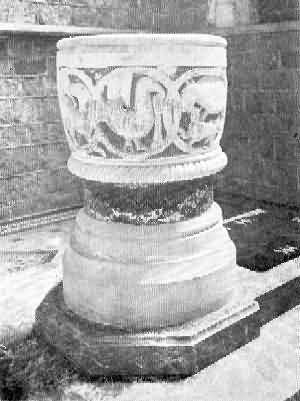
St. Mary Church: Font, 2
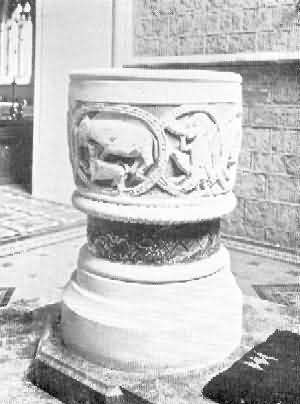
St. Mary Church: Font, 3
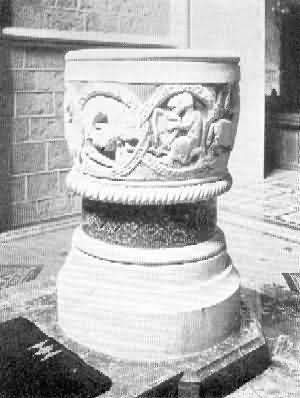
St. Mary Church: Font, 4
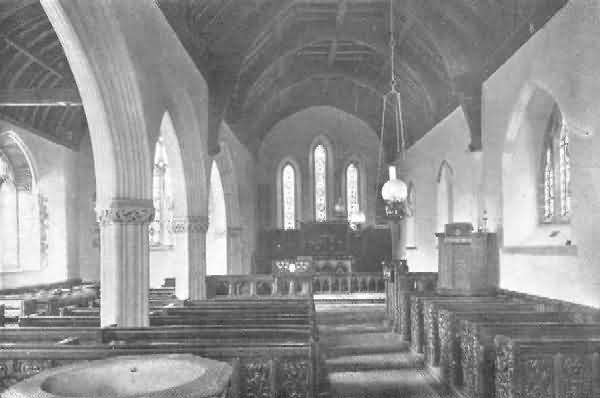
Stockleigh Pomeroy: Interior
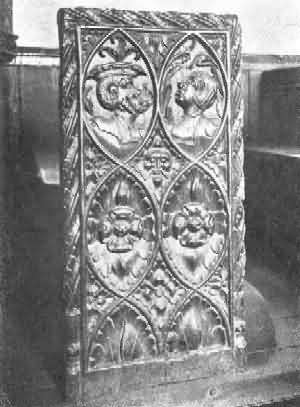
Stockleigh Pomeroy: Bench-End, 1
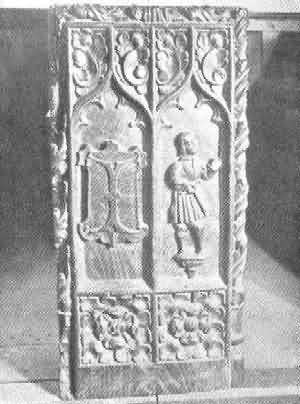
Stockleigh Pomeroy: Bench-End, 2
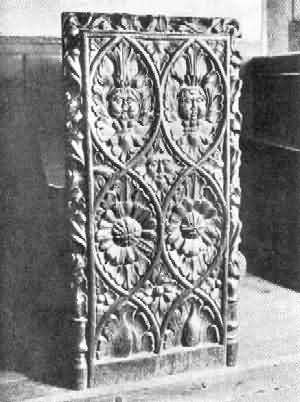
South Milton: Bench-End, 3
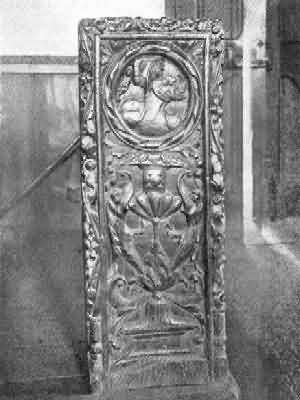
Stockleigh Pomeroy: Bench-End, 4
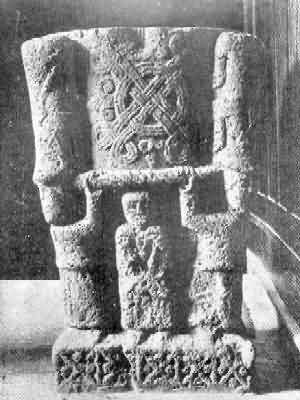
Stoke Canon: Font, East Side
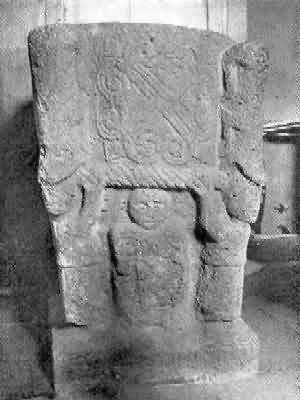
Stoke Canon: Font, South Side
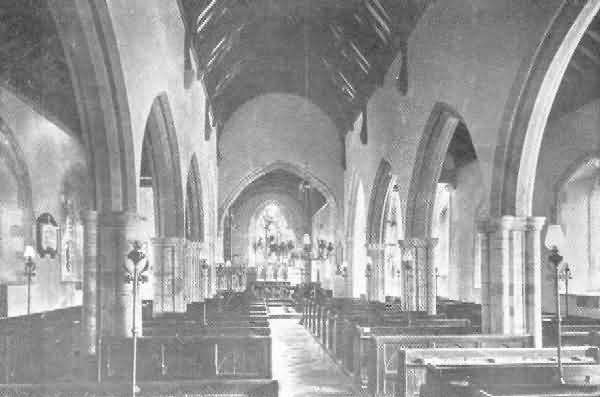
Stoke Fleming: Interior
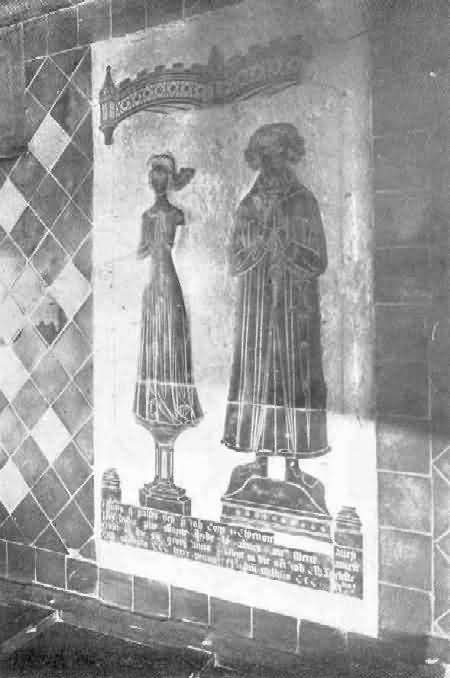
Stoke Fleming: Corp Brass
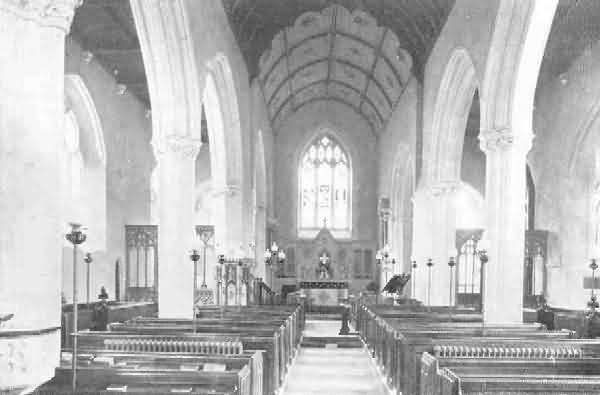
Stoke Gabriel: Interior
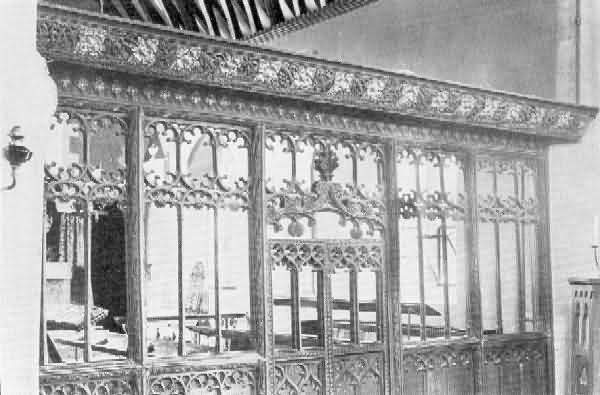
Stoke-in-Teignhead: Rood Screen
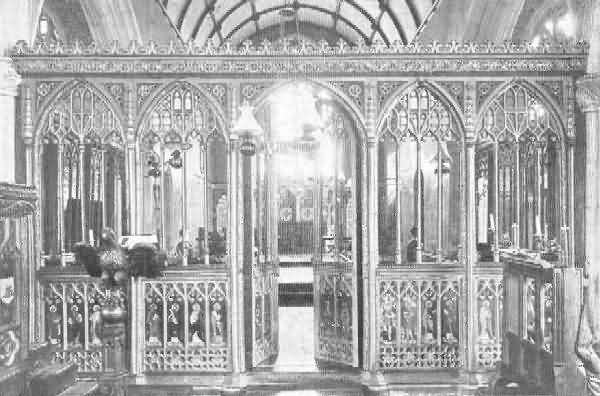
Stokenham: Rood Screen
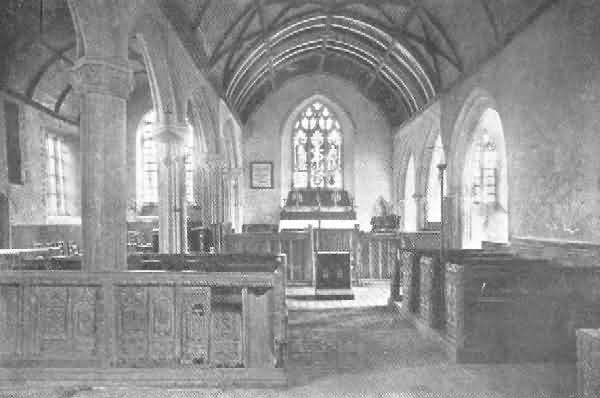
Sutcombe: Interior
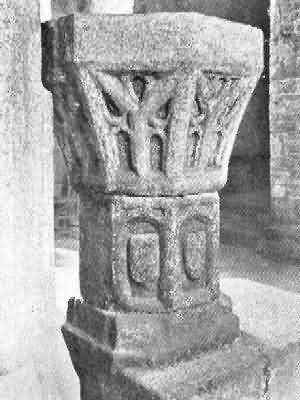
Sutcombe: Font
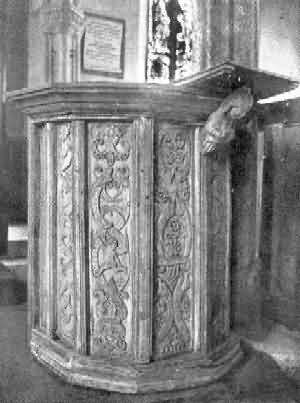
Sutcombe: Pulpit
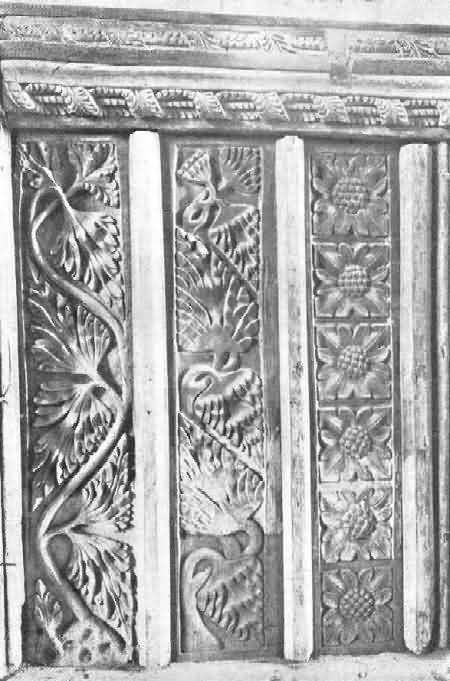
Sutcombe: Panels of Rood Screen, 1
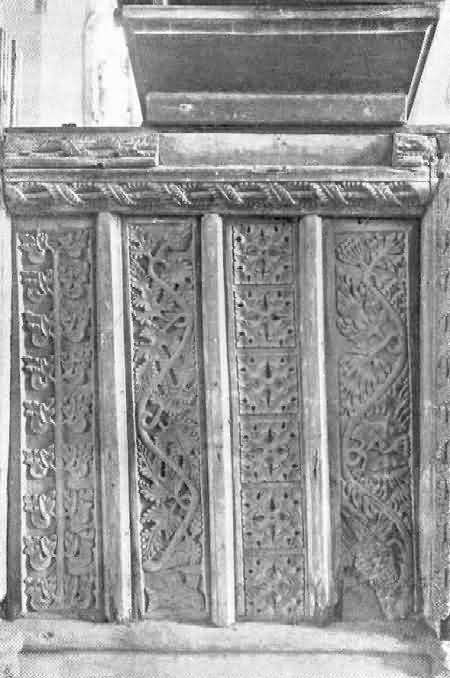
Sutcombe: Panels of Rood Screen, 2
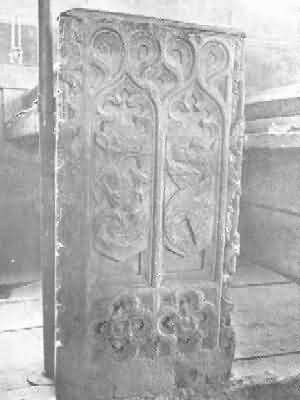
Sutcombe: Bench-End
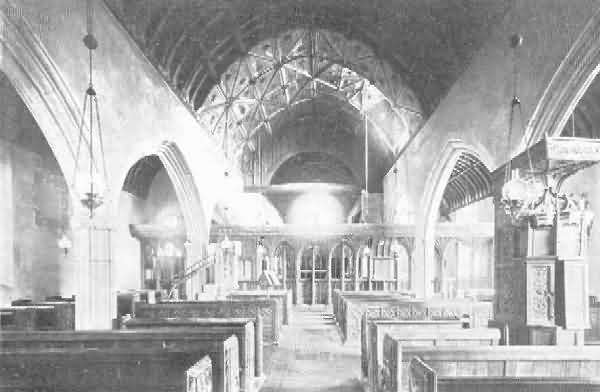
Swymbridge: Interior
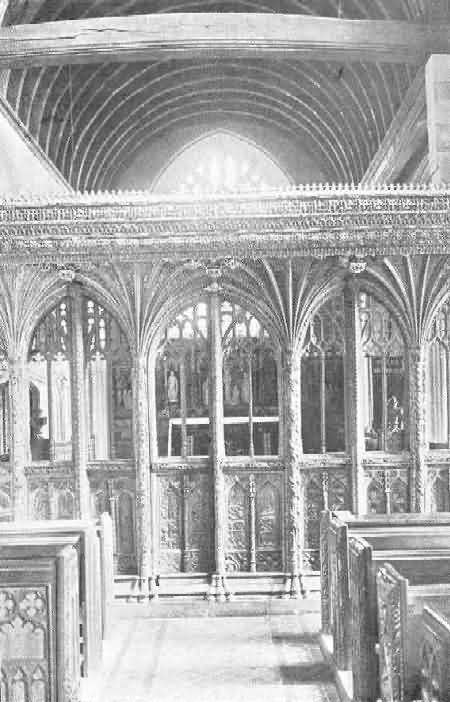
Swymbridge: Rood Screen
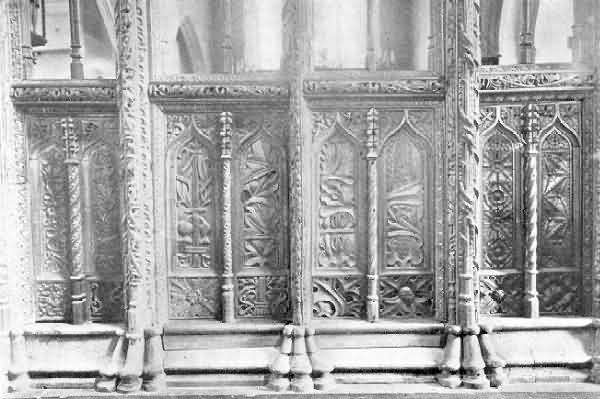
Swymbridge: Carving on Panels of Screen
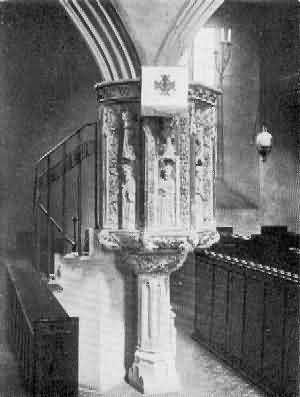
Swymbridge: Pulpit
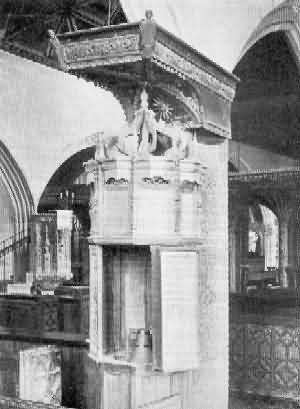
Swymbridge: Font
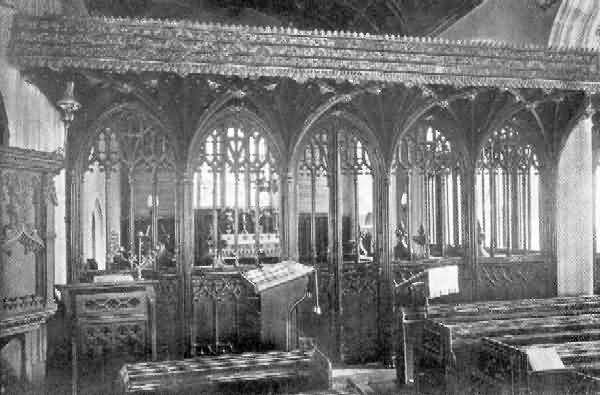
Talaton: Rood Screen
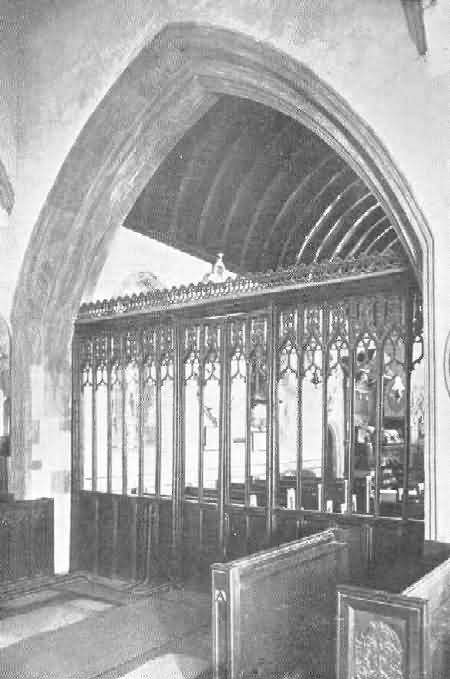
Tawstock: Chancel Screen
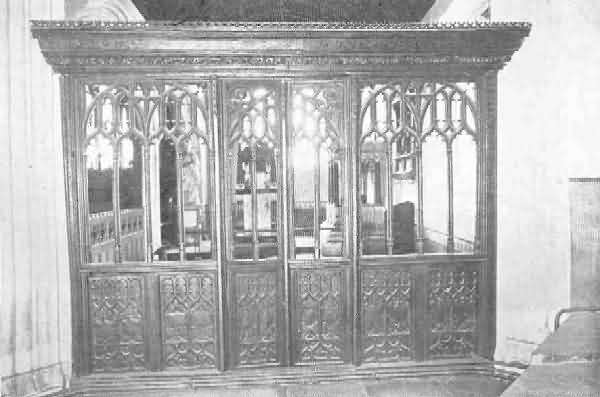
Tawstock: South Aisle Screen
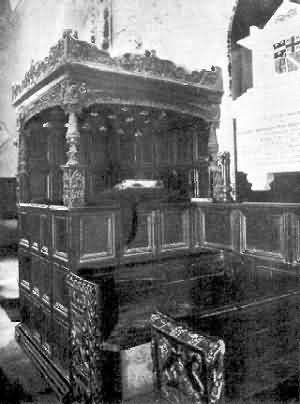
Tawstock: Manorial Pew
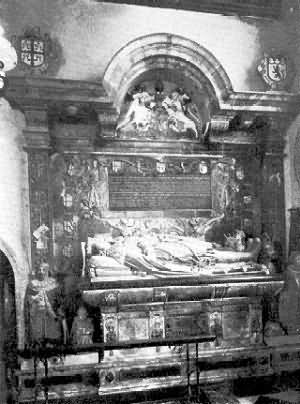
Tawstock: Bourchier Monument
«Some Old Devon Churches»:
Index; 229-240
[Dr. R. Peters: rpeters@wissensdrang.com]